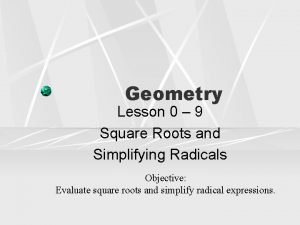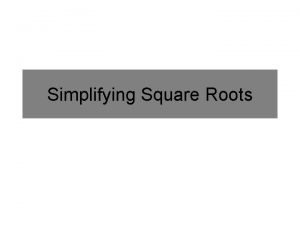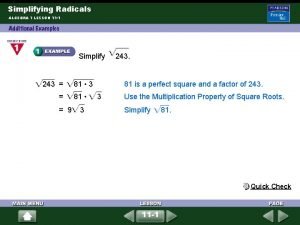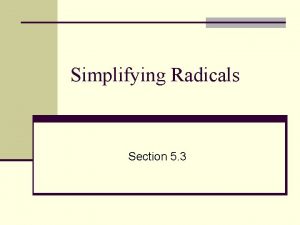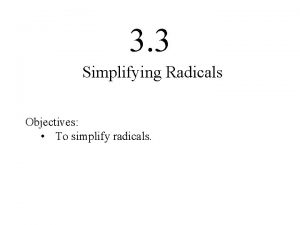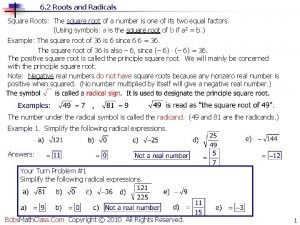SIMPLIFYING SQUARE ROOTS Definition of radicals Square roots











- Slides: 11

SIMPLIFYING SQUARE ROOTS

Definition of radicals Square roots usually show up in radical signs. “Radical” is another word for root: The square root of 9 is written:

Definition of radicals The radical sign is the “house” that the radicand lives in. The index tells you which kind of root it is. The radical sign with no index showing means the principal (or positive) square root.

Simplifying radicals Exponents and their corresponding roots are opposite operations – just like adding and subtracting or multiplying and dividing. If you square a positive number and then take the square root of the answer, you’re right back where you started from.

Watch those signs! Keep in mind that squaring a number produces a positive answer. If you square a negative number and then take the square root of the answer, you’ve made it positive.

Fractional exponents Another way to express a root, is to write a fractional exponent. An exponent of ½ means the square root

Fractional exponents When you are simplifying radicals, one way to do it is by thinking of the radical as a fractional exponent and applying the laws of exponents. Remember that when you raise a power to a power you multiply the exponents.

Alternate reality An alternate way to get the same answer, is by breaking the radicand down into prime factors and then using the index to tell you how many identical factors need to be in a group to move out of the house. For example: Since the index is understood to be 2, a pair of 2’s can move out, a pair of x’s can move out and a pair of y’s can move out. Note, for each pair, only one shows on the outside.

Some more examples If there is a negative outside the radical, the answer is negative.

Even roots of negative numbers If there is a negative inside the radical, there is no solution within the set of real numbers. That is because there are no two identical numbers (same signs) that multiply to give a negative. Positive times positive = positive negative times negative = positive

ALWAYS SIMPLIFY Whenever you have a radical, simplify if you can!
 0/9 simplified
0/9 simplified Dmca square root
Dmca square root 72 radical form
72 radical form Adding unlike radicals
Adding unlike radicals Unit 11 radicals homework 5 dividing radicals day 1
Unit 11 radicals homework 5 dividing radicals day 1 Simplifying radicals worksheet no variables
Simplifying radicals worksheet no variables Can you multiply radicals
Can you multiply radicals Simplify each radical expression
Simplify each radical expression Rationalizing radicals
Rationalizing radicals Unit 7-1 simplifying radicals answer key
Unit 7-1 simplifying radicals answer key Simplify square root of 252
Simplify square root of 252 Simplifying radicals jeopardy
Simplifying radicals jeopardy
